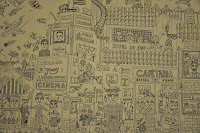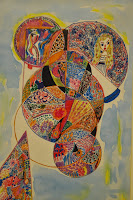The "Mental Health and Art - expressing oneself" exhibition integrated in the commemoration of the official International day on mental health was initially on display at Museu Nacional Soares dos Reis, having later been exhibited at Museu do Oriente (till tomorrow).
I must say this is not the exhibition I was going to go to but feel particularly privileged to have been given the opportunity to watch it, not only because I was touched (by it) but also because it made me ponder on quite a few questions regarding what mental health really is, how one can define its boundaries and which are some of the main causes therewith associated.
Some of the works of Art had a strong impact on me and as there wasn't but the reference to the name of the various artists (with the exception of those which corresponded to self portraits) and the institutions they are either kept at or attend I attempted to put a face to their authors based on what I could see beyond the painting or even based on some of the words that were scribbled on several of them, some of which very profound.
I would have liked to have known a bit more about these artists (having been quite "intrigued" by some of them), because irrespective of being expressions of mentally disturbed, unbalanced or bipolar people there is recognisable artistry in them and inner messages being conveyed in most of those paintings, (I would say in my rather humble opinion).
The six drawings that follow belong to a certain Artur Moreira - Centro Hospitalar Psiquiatrico de Lisboa. They speak for themselves ... and yet the author has opted to write
" my position in regards to Art is a priori one of great satisfaction, I therefore attempt to attain the unattainable by exploring the techniques of expression whenever I can. The fear of the unknown has had me armouring myself with the courage to face both the sacrifice of the creation and the fearful fear of the blank sheet of paper ..." (free translation)
" my position in regards to Art is a priori one of great satisfaction, I therefore attempt to attain the unattainable by exploring the techniques of expression whenever I can. The fear of the unknown has had me armouring myself with the courage to face both the sacrifice of the creation and the fearful fear of the blank sheet of paper ..." (free translation)



The next three made by Maria Cândida Craveiro Lopes Couceiro - Casa de Saude da Idanha - Irmãs Hospitaleiras do Sagrado Coração de Jesus, did catch my fairly inquisitive attention, particularly "seagulls within me" with the phrase "Mozambique will triumph" just above the wing.
"Gaivotas em mim" (seagulls within me).

"Brincadeiras" (playing) - left. "Faces"(faces) - right.
The next two were painted by a certain Isabel Serra Matias - Fundação Assistência, Desenvolvimento e Formação Profissional - Miranda do Corvo. My attention was particularly drawn to the one called "tenderness" as I wondered to which extent a given relationship had had any influence on her situation, whichever it might be ...

"Ternura" (tenderness) - left. "O imaginario" (the imaginary) - right.

José Capela - Hospital Magalhães Lemos - Porto.
Casa de Saude São Rafael - Angra do Heroismo, Azores by Mestre Abreu (1947-1984), the only painting which has been dated because of having been acquired by a museum, Museu São João de Deus.
At times, throughout the exhibition I asked myself if some of these people had learned any artistic techniques before having been taken into the Mental Health hospitals and Institutions they are (were) at, and again the answer was left unanswered because of the shortage of information (or rather absence of it).
"O luar e a cidade" (moonlight and the city) by Pedro Freitas - Centro Hospitalar e Universitario de Coimbra.
"O principio" (the beginning) by Jorge Figueiredo - Centro Hospitalar de Vila Nova de Gaia e Espinho.
"Natureza morta com ananas" (still life with pineapple) by Miguel Almeida - Grupo Acção Comunitaria, Lisboa.
Aldo José Martins S. Matos' drawing with the following words of Cid written on it
"Once upon a rather macabre day I fell and let myself sink like a fool and life stopped there and then ... and yet on a once upon happier day I found myself here so as to begin achieving what I never did ..." (free translation).

"A geometria das emoções" (the geometry of the emotions) and "A geometria da dualidade" (the geometry of the duality), copies of "Dor de Espanha"(1938) of Wilfredo Lam by Nuno Nobre - Associação de Saude Mental do Algarve, Faro.
O homem da auto-estrada" (the man of the highway) by Mario Silva - Associação de apoio aos doentes depressivos e bipolares - Delegação Centro, Coimbra.
As far as one of the particular "artists" is concerned I couldn't help finding some similarities to Frida Kahlo's personal experiences being "exorcised" onto the canvas ...


"Without title" by Jorge Dias - Centro Hospitalar e Universitario de Coimbra
João Mendão sketches on paper napkins - Associação de Saude Doutor Fernando Ilharco, Setubal
The self- portraits that follow (two of which are faceless) were all made at Casa de Saude do Telhal, Instituto S. João de Deus. I was once more intrigued, this time with the fact that two of the self-portraits apparently belonged to the same person, one being faceless though one of the facial characteristics could be slightly identifiable (the boldness and the way the hair fell on the side, irrespective of being completely white in one of the portraits).
When were they painted? Which one preceded which? (not that I might have reached any plausible explanation, but it reminded me of having initially asked some of the children in Cape Verde during my first community project to have them do their self portraits, to which they responded because they had never seen themselves ...) Could it be that this man had never considered himself important as a person or even been acknowledged by others as being important and this fact could therefore be accounted for his "invisibility" ...
I am just hypothesising, but I would have really liked to have had further information on the potential dates and whether the "faceless" self-portrait had been painted before or after having been made "aware" of his mental health situation.
I am just hypothesising, but I would have really liked to have had further information on the potential dates and whether the "faceless" self-portrait had been painted before or after having been made "aware" of his mental health situation.

Gastão José Afonso Rodrigues (left). Vitor Manuel Estevão Teixeira (right).

Henrique Manuel Costa Lopes Nunes
José Manuel Sousa Ribeiro

"Senhora no restaurante" (lady in the restaurant) - left. " Paulinho" (Paulinho) by Hélia Soledade - Centro de Apoio Social de Pisão, Santa Casa da Misericordia de Cascais.

"Without title" by Manuel Gomes - Centro Hospitalar Conde de Ferreira, Santa Casa da Misericordia do Porto (left). "Self-portrait" by Hipolito Carvalho - Centro Hospitalar Conde de Ferreira to which he added the following scribbled words "Self-portrait Hipolito, to whom Esmeralda says we might have been so happy had I not got sick."
"Mulher com animal" (woman with animal) by Hélia Soledade - Centro de Apoio Social de Pisão, Santa Casa da Misericordia de Cascais.
Looking at this last representation of Hélida it simply occurred to me that each of us may carry along an "animal" within or outside oneself that may "assume" every possible form, from a bad memory to a particular character and that in itself may either be controllable or not depending on the role that "demon" has played or still plays in one's life. Being able to live with "demons" without letting them affect one's life, thus maintaining a certain degree of mental health, may be difficult at times and may eventually be associated to one's fragile or less fragile nature ... (I don't know ... I am just voicing some of my inner thoughts as to what may lead people to feel unbalanced or "outcast").
Maybe we should be taught to "express" ourselves more often and from an earlier age, in order to hear our voice or let it be heard (eventually) without further damages ...
























No comments:
Post a Comment